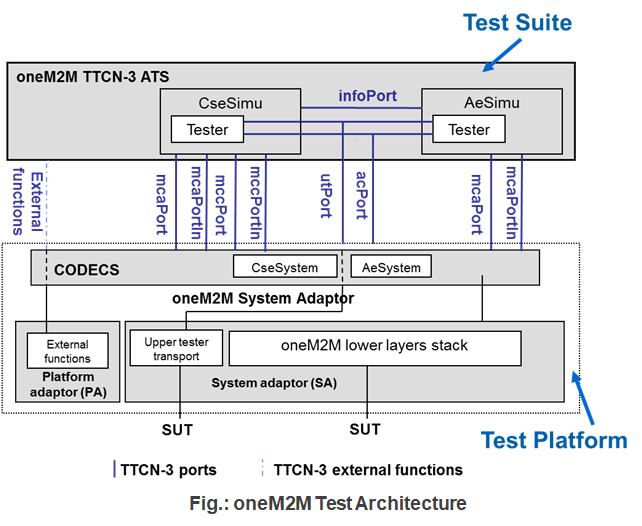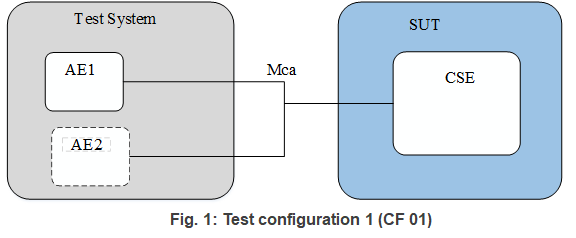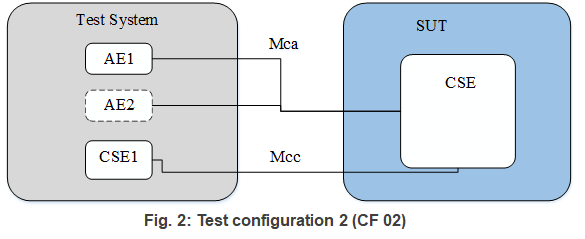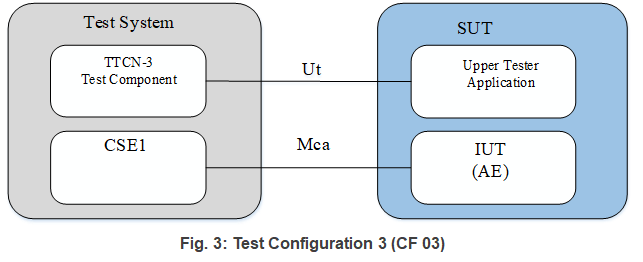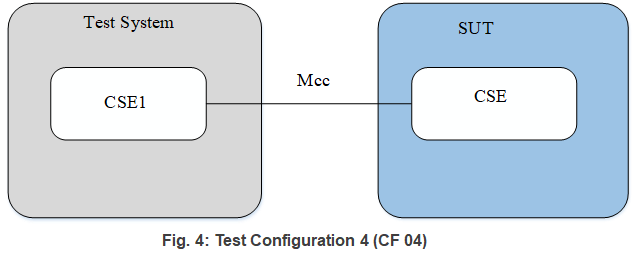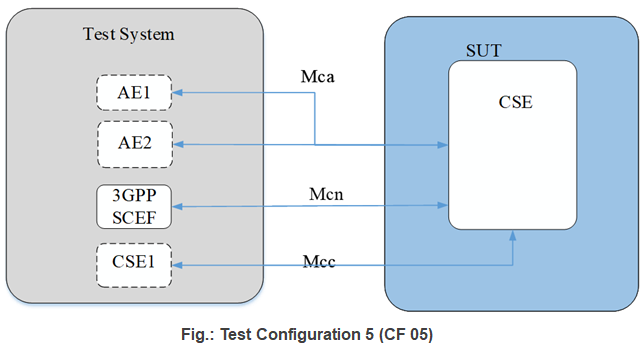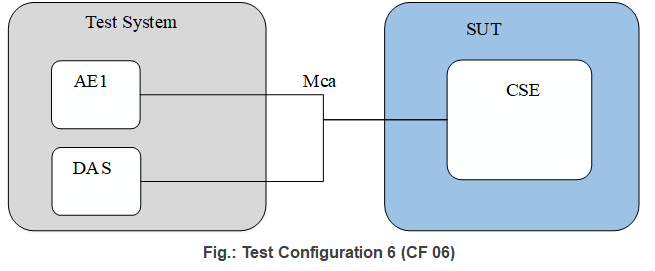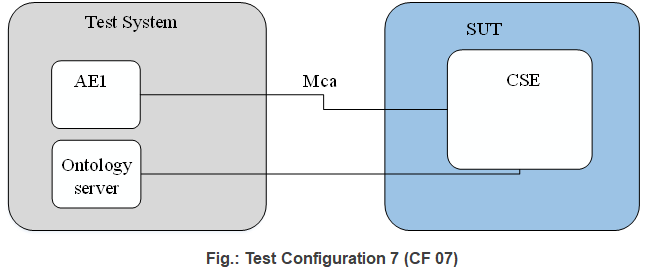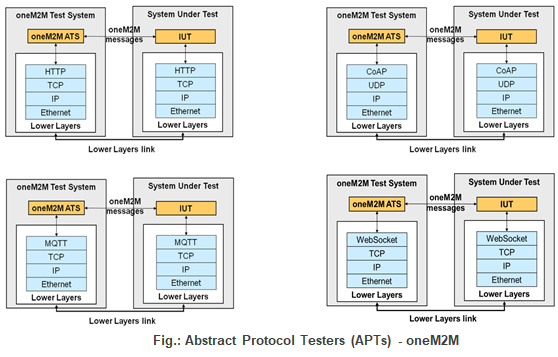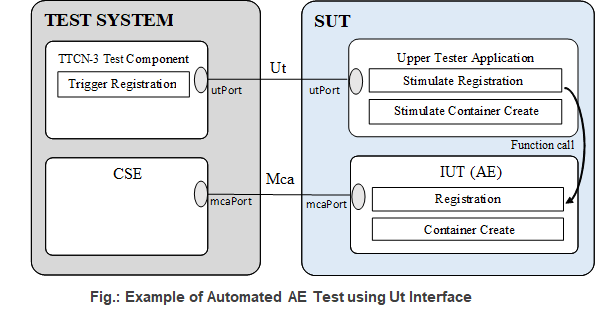The objective of the oneM2M Test Suite is to provide a basis for Conformance Tests for oneM2M Products giving a high probability of Inter‑Operability between different Manufacturers' Equipment.
oneM2M Test Suite Structure (TSS) and Test Purposes are designed to evaluate the Conformity of oneM2M Implementations to the oneM2M Specifications. It also specifies
- Guidelines for Description of Test behaviours and Definition of Test Purpose Structure,
- Notations to define a Test Purpose for Conformance Testing, and
- Test Configurations for Conformance Testing.
Fig. 1 and Fig. 2 below show CSE Test Configurations where CSE as a IUT (Implementation Under Test) can be tested against TTCN-3 Test System, which is acting as AE or AE and CSE respectively. Test System may include as well other Entities which are necessary for each configuration, i.e. a second AE (AE2) for receiving notifications These entities are represented with dashed rectangles.
Fig. 3 below shows AE Test Configuration (CF03) for ADN-AE testing scenario where ADN-AE is IUT and TTCN-3 Test System is acting as a CSE.
Fig. 4 below depicts test configurations between two (2) CSEs, where one (1) CSE is acting as a Test System, the other is SUT (System Under Test).
Fig. 5 below shows test configurations for 3GPP Interworking Testing Scenario where 3GPP SCEF is working in a Test System.
Fig. 5 below shows Test Configuration for 3GPP Interworking Testing Scenario where 3GPP SCEF is working in a Test System.
An Abstract Protocol Tester (APT) is a process that provides behaviours for testing an IUT (Implementation Under Testing) by emulating a peer IUT at the same layer, and enabling to address a single test objective.
APTs used by the oneM2M Test Suite are described in Fig. APTs. The Test System will simulate valid and invalid protocol behaviour, and will analyse the reaction of the IUT.
As Fig. APTs below illustrates, the corresponding ATS needs to use Lower Layers to establish a proper connection to the System under Test (SUT) over a physical link (Lower Layers Link). Four (4) different Lower Layers have been specified corresponding to the binding Protocols considered in oneM2M: HTTP, CoAP, WebSocket and MQTT.
Test Suite Structure (TSS)
Test groups
The test groups are organized in two (2) levels. The first (1st) level defines the functional entity of oneM2M. The second (2nd) level defines the Common Services Functions (CSFs) which are represented in oneM2M functional architecture.
Functional Entity Groups
The functional entity groups identify the types of entity which are specified in oneM2M functional architecture(TS-0001 [1]).
- AE
- CSE
Common Services Functions (CSF) Subgroups
The Common Services Functions (CSFs) subgroups identify the general procedures in each Common Services Functions (CSFs) specified in oneM2M Functional Architecture:
- Registration
- Data Management and Repository
- Subscription and Notification
- Group Management
- Discovery
- Location
- Device Management
- Communication Management and Delivery Handling
- Security
Test Suite Structure (TSS) for oneM2M
The Test Suite Structure (TSS) for oneM2M will be present as below:
- Group 1: General Capability (GEN):
- Subgroup 1.1: Protocol Bindings
- Subgroup 1.2: Serializations
- Group 2: AE(AE):
- Subgroup 2.1: General Capability (GEN)
- Subgroup 2.2: Registration(REG)
- Subgroup 2.3: Data Management and Repository(DMR)
- Subgroup 2.4: Subscription and Notification(SUB)
- Subgroup 2.5: Communication Management and Delivery Handling(CMDH)
- Subgroup 2.5.1: Request Message Polling(PCH)
- Group 3: CSE(CE):
- Subgroup 3.1: General Capability (GEN)
- Subgroup 3.2: Registration(REG)
- Subgroup 3.3: Data Management and Repository(DMR)
- Subgroup 3.4: Subscription and Notification(SUB)
- Subgroup 3.5: Group Management (GMG)
- Subgroup 3.6: Discovery (DIS)
- Subgroup 3.7: Location (LOC)
- Subgroup 3.8: Device Management (DMG)
- Subgroup 3.8.1: Data Management using Time Series for (TS)
- Subgroup 3.9: Communication Management and Delivery Handling (CMDH)
- Subgroup 3.9.1: Request Message Polling(PCH)
- Subgroup 3.9.2: Response Type (RT)
- Subgroup 3.10: Security(SEC)
- Subgroup 3.11: Resource Announcement (ANNC)
- Subgroup 3.12: 3GPP Interworking (3GPP)
- Subgroup 3.13: FlexContainer (FLXC)
- Subgroup 3.14: Dynamic Authorization (DAU)
- Subgroup 3.15: Semantic (SEM)
- Subgroup 3.16: Initial Service Provisioning (ISP)
- Subgroup 3.17: Service Charging and Accounting (CSA)
- Subgroup 3.18: Service Subscription User Profile (SSUP)
- Subgroup 3.19: Primitive Profile (PP)
